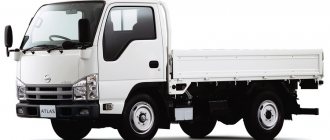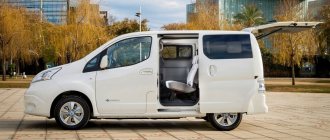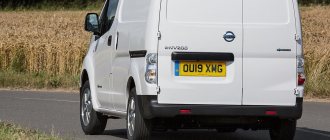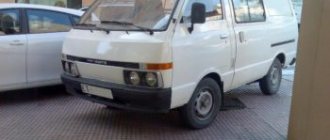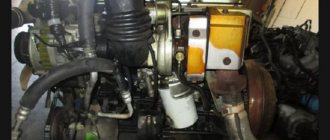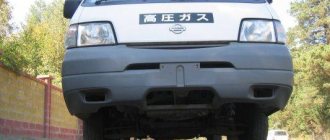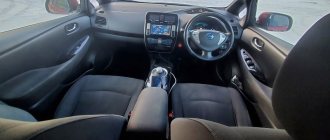The Nissan NV200 is used both in business and for family needs and travel. They are made both five-seater and two-seater. With one row of seats or two. All variants have very spacious trunks. When using the spaces under the front passenger seats, three-meter loads can be transported.
Models with 4-cylinder engines with variable valve timing. With a maximum power of 109 horses, a thrust of 15.5 kg/m. The transmission is a five-speed manual or 4-speed automatic. Consumption is 7.1 liters per 100 km, which allows motorists to enjoy tax benefits.
Exterior of Nissan NV200
Important! Multifunctional minivans are available in three body configurations.
The Nissan NV 200 has sliding side doors on both sides that are convenient for maintenance and use. Therefore, you can park on the side of the road in any way. In order to transport people, spacious cabins have been created. For cargo there are spacious and comfortable bodies.
Here are the varieties of Nissan NV200:
- Trucks are vans that have spacious cargo compartments and cabs with two seats for drivers and passengers.
- Station wagons with a combination of trucks and passenger compartments. The Combi has additional seats with two rows. They fold down to accommodate large loads.
- Evalia passenger family minivans are “luxury” options that are designed for long-distance travel.
- City taxis with panoramic sunroofs. They also have comfortable seats and trunks. The cars are comfortable to get into.
Nissan e-NV200 driving: it's almost a LEAF!
I examine the Nissan e-NV200 and see in front of me a typical van, colloquially referred to as a “pie”: an almost single-volume body, a small hood, a huge interior and rectangular doors. But can the Nissan e-NV200 be called a van? After all, this test car is presented in a 5-seater passenger version and claims to be a “family minivan”, only adjusted for electric technology from LEAF. By the way, the latter is recognizable in literally every detail - the appearance of the Nissan e-NV200 is filled with quotes from its popular electric car relative: a charging hatch in the nose, a lot of brand logos and blue accents, original slanted headlights (in regular versions of the Nissan NV200 simpler headlights are used).
The Nissan e-NV200 electric car is a 5-seater minivan, but there is also a 7-seater version and a 2-seater cargo van. We expect the design: high body, short hood, large rectangular doors. But the electric modification received a number of characteristic details: a charging hatch, company logos, original headlights. Dimensions are average for its class: length – 4,560 mm; width – 1,755 mm; height – 1,858 mm; wheelbase - 2,725 mm. The electric car weighs 1,517-1,641 kg, depending on the configuration and installed equipment.
Inside, the Nissan e-NV200 is also a mixture of the regular NV200 and the LEAF. In front of the driver and passenger there is a large, wide panel; It may be basic hard plastic, but there are plenty of shelves and cup holders, plus a box organizer between the front seats. When looking at the instrument panel, your eye catches on the stylish round “everything indicator”: speed and power reserve, consumption or energy recovery scale, selected driving mode. On the left is a block of control indicator lamps. On the right is a multifunctional LCD display: selecting the position of the “automatic” lever (although there is no traditional automatic transmission); battery charge level in percent; time until the battery is fully charged; battery temperature; average speed; tire pressure; etc.
The automatic selector is installed on a separate podium in the center console and offers the usual positions: PRND; change of position is stepwise, vertically. There is also a separate mode “B” (Brake), which is activated by moving the lever from position D to the side horizontally. In this case, the intensive recovery mode is activated, the electric vehicle slows down more when the accelerator pedal is released, but it also collects more energy than usual. There is an “ECO” mode button nearby: it reduces the acceleration dynamics, but this way you can drive a little further. At the bottom of the mentioned podium are buttons for heating the seats and steering wheel, which is important for an electric car.
The interior is generally identical to the regular Nissan NV200 model, but in detail it clearly resembles the LEAF: the connection can be seen in the logic of various devices created specifically for the electric vehicle; here are identical “driving” modes (P—R—N—D/B), which are selected using a lever on the center console; There is a familiar “ECO” button.
But also attention is drawn to the large number of pocket shelves in the front part of the cabin: several cup holders, a large niche shelf on the center console, a folding organizer between the front seats - yes, this is a real minivan! Traditionally for an electric car, a heating option has been thought out: not only the seats are heated, but also the steering wheel.
The Nissan e-NV200 electric car also drives similar to its famous brother: easy starting from a standstill; quite dynamic acceleration to “city” 50-60 km/h; however, the closer to 100 km/h, the more difficult it is for an electric car to gain momentum. This is not surprising: the Nissan e-NV200 is tall and has a large front end; and the vertical rear clearly does not improve aerodynamic qualities. Plus, due to the large flat sidewalls, the influence of crosswinds is felt on the track. In short, the Nissan e-NV200 electric car is clearly not designed for dynamic driving, which is confirmed by the stated speed characteristics: acceleration from 0-100 km/h in 14 seconds and 123 km/h at maximum speed.
But as soon as you slow down and drive in “family van” mode, everything will immediately fall into place. Comfortable suspension, minimum attention to small irregularities (especially on winter tires); very light steering and small turning circle. From the comments on the suspension: body roll and slight sway on very large waves of the road - after all, the high body has not gone away.
Hidden in the engine compartment of the NV200 model is LEAF technology - an EM57 electric motor (109 hp and 254 Nm) plus a single-stage gearbox (gear ratio 9.3:1). Depending on the selected modification of the electric vehicle, the Nissan e-NV200 offers a built-in converter for charging with a power of 3.3 kW or 6.6 kW - the charging speed of the 24 kWh battery directly depends on this (7-8 hours or 4-5 hours, respectively). There is a CHAdeMO connector for fast battery charging in the “80% battery in 30 minutes” mode.
I keep saying “LEAF-LEAF...”, but the Nissan e-NV200 is not a LEAF! To be convinced of this, just look into the rear of the cabin. Yes, here, simple panel trim and seat upholstery. But there is so much space in the second row that small children can play hide and seek there: a huge amount of headroom and plenty of legroom; the width of the cabin allows three adults to sit back without any problems; There are no problems with the floor level either. At the same time, there is also a huge trunk behind the passengers: the manufacturer claims a useful volume of the luggage compartment of 2.3 cubic meters. m with a 5-seater cabin and 3.1 cu. m with the second row seats folded. In addition, there is a commercial van Nissan e-NV200, where the useful volume of the luggage compartment reaches 4.2 cubic meters. m (I’ll talk about this below).
In addition to the nominal numbers in the “everything is fine” style, attention is paid to the elaboration of details. For example, the Nissan e-NV200 electric car presented in this article has two sliding side doors; each of them has a window for ventilation. The second row seats, despite their simple appearance, can offer backrest angle adjustment. The luggage compartment has a pocket for small items; and swing doors, when the locks are removed, can open to an angle of up to 180 degrees, which allows you to drive as close as possible to the loading and unloading area.
The rear of the cabin is where the strength of the Nissan e-NV200 lies! There is a lot of space, adjustable and folding seats, two sliding doors and vents for ventilation, a large trunk with well-thought-out “little things” like a pocket or completely swinging doors.
Trucks and minivans Nissan NV200
Options:
- Length - 4 m 400.
- Width - 1 m 695.
- Height - 1 m 860.
- Ground clearance - 16 cm.
- The wheelbase is 2 m 725.
- Track width: front/rear 1 m 490 and 1 m 510.
- Gross weight - 1 t 725.
- Fuel tanks with a volume of 55 liters.
Transverse-mounted four-cylinder in-line engines. They run on gasoline and diesel fuel.
- Gasoline engines with 1.6 liters, diesel engines with 1.5 liters.
- With power -109/86/110 hp.
- With traction - 152/200/42 Nm.
- With maximum speeds of 170/160 km/h.
- Consumption - 7.8/5.5 liters per 100 km.
They work together with a five-speed manual transmission and on front-wheel drive. With front disc and rear spring brakes. The suspension elements in front are independent springs, in the rear they are drum type.
avtoexperts.ru
When the question arises, which budget car is suitable for traveling with a large family and the ability to transport luggage, many will point to the popular Lada Largus. But what if you need a more spacious interior and trunk? What if you don’t want to get involved with the Russian auto industry and want something foreign, for example, from Germany or Japan. But German cars like the Volkswagen Caddy Life Maxi cost more and are more expensive to maintain, while Japanese cars are cheaper and no less reliable. Following this logic, a Nissan NV200 was purchased on the secondary market. We will discuss its advantages and disadvantages in today's review.
Nissan NV200
Nissan NV200 Vanette is a utility minivan, essentially a minibus with sliding side doors. It has a very typical appearance for similar models from Japan. The car is tall, narrow and long.
By the way, due to the structural features of the body, windage occurs while driving. For example, when you are driving along the highway and a truck drives towards you, the car sways a little. Also, the car is not particularly stable when cornering.
There is plenty of space in the cabin. Visibility is excellent - you sit high, you can see far away. Sitting in the driver's seat, you get the feeling that you are driving a minibus.
Inside the Nissan NV200 Vanette
The simplest basic equipment includes an anti-lock braking system ABS, driver airbag, air conditioning, and electric windows. An additional two-din radio was installed.
As for the right-hand drive, at first it’s unusual and you catch unusual sensations, but after a while you get used to it.
Interior
If you pay attention to the second and third row of seats, you can see that they are non-standard. From the factory there was a rear seat here, and there was a huge trunk in the back. Now the second and third rows have seats from Hyundai Grand Starex. The two rear seats can be easily removed if necessary.
Inside the Nissan NV200
According to the manufacturer, the length of the luggage compartment without the rear rows of seats is 2040 mm, and the volume is 4.2 cubic meters. With one rear sofa, the volume will be 2.3 cubic meters. Load capacity – 771 kg. The maximum load height is 1.36 meters.
It was like this
Under the hood is a 1.6 petrol engine (HR16DE), with a power of 109 horsepower and a torque of 153 Newton meters. The engine is paired with a Jatco JF404E 4-speed automatic transmission.
Under the hood of the HR16DE
It is clear that with such an engine this rather large car will not go fast. Overtaking must be carefully calculated, and it is better not to overtake again. Comfortable speed on the highway is no more than 110 km/h. If you drive faster, the engine begins to howl, strain, and fuel consumption increases. If we talk about consumption, then with a quiet ride the average consumption will be 7-10 liters of AI-92 fuel.
If we talk about the reliability and service life of these units, the main thing is to change the oil and filters on time and fill in with high-quality fuel. Then the service life of the engine and gearbox on the Nissan NV200 can be more than 300,000 km, or even more.
In addition to the 1.6-liter engine, the model can be equipped with a 1.5 dCi (K9K) turbodiesel with a power of 86 horsepower and a torque of 200 Newton meters. The diesel engine is paired with a 5-speed manual transmission. Such modifications, as a rule, were produced for Europe and have a left-hand drive.
For the North American market, the NV200 is offered with a 2.0 engine (MR20DE), paired with a continuously variable transmission.
As for the suspension, there is an independent MacPherson spring at the front and a dependent spring at the rear. It feels like the suspension is stiff. When driving, you can feel the unevenness of the road, especially potholes, which are best avoided or driven at a very low speed.
Instead of output
As a result, we have a very roomy, simple and reliable car at a relatively low cost. On the market, such a car produced in 2014 is valued at 700-750,000 rubles. Is it worth buying? If right-hand drive doesn’t bother you, you have a large family or are engaged in cargo transportation, or take tourists to nature, then this option is acceptable. If not, there are other options on the market. For example, among competitors, in addition to Lada Largus, you can consider Peugeot Partner, Renault Kangoo, Volkswagen Caddy, Nissan Serena, Toyota Estima and others. It all depends on your preferences and financial capabilities.
Electric vehicles with NV200 base
They are recognizable by their external features. The front instrument panels have been redesigned. These are universal, environmentally friendly electric cars. They have absorbed all the best characteristics. Everything that could be good could be taken from the NV200 and Leaf.
Electric cars operate with synchronous, three-phase motors. With lithium-ion batteries, which have 48 blocks and weigh 300 kg. Cars have a power of 107 horsepower. Thrust - 280 Nm. They race at a top speed of 120 km/h, with a maximum range of 170 km on a single charge.
Nissan e-NV200 design: van or minivan, 24 kWh or 40 kWh
The Nissan e-NV200 first appeared as a concept car in the spring of 2012, when it became clear that the LEAF had “gone”: the Japanese were looking for other options for using their technology. Serial production of the Nissan e-NV200 started in 2014, the electric car received the equipment described in this article: an 80 kW (109 hp) electric motor and a 24 kWh battery. Interestingly, at the end of 2022, the manufacturer announced an updated version of the Nissan e-NV200, where the main change is an enlarged 40 kWh battery (apparently from the second generation LEAF). The range also increased in a similar way: the 24 kWh version promised a range of 170 km, the new modification should travel 270 km; all figures are based on NEDC measurement cycle data.
But in reality the mileage is noticeably shorter: when I drove there was noticeable frost, the heater was on - the range was 100-115 km on 100% battery charge. In ideal conditions - warm and dry, no need to turn on the heater or air conditioner, ECO mode - an electric car can travel about 130-150 km on a single battery charge. When partially or fully loaded, the power reserve will be 100-130 km. Accordingly, from the version with an enlarged 40 kWh battery, you can expect a real range of about 200-250 km in good weather and light load, or about 150-200 km in cold weather and significant load.
By the way, about loading. In addition to the 5-seater passenger version, which became the hero of this article, the Nissan e-NV200 is also available in other modifications: a commercial van (2 seats in the cabin and a cargo compartment with a useful volume of 4.2 cubic meters) or a family minivan Nissan e-NV200 Evalia (5- or 7-seater saloon, improved finishing).
The Nissan e-NV200 electric car is available in different versions: commercial van, Combi passenger version, Evalia minivan. Depending on the selected version, the number of seats in the cabin, rear doors (two hinged or one lifting), interior trim, and available options change. The load capacity also changes: up to 770 kg in the cargo version or up to 650-700 kg in passenger versions (depending on the weight of the specific modification, taking into account the equipment).
If we sum up the intermediate results, then the Nissan e-NV200 electric car suddenly turns out to be, perhaps, the best electric “pie” compared to the Citroen Berlingo Electric and Renault Kangoo ZE: a wider choice of versions by body/interior type; more powerful motor and more dynamic acceleration; known technique; The controls are better thought out for an electric vehicle (LEAF experience!), there is a larger battery and a fast charging function (CHAdeMO).
And the main thing is the question of price...
And now let's return to the question with which we started - why is the Nissan e-NV200, with all its advantages, so rarely seen on the roads?
It's simple - price. For example, the electric car in the article is sold for $26.5 thousand; This is a 2015 model. with a mileage of 14.5 thousand km, well equipped: rear view camera, keyless entry, branded multimedia, climate control, heated seats and steering wheel, electric windows, etc. But a Nissan LEAF comparable in age and mileage costs $16-18 thousand . – i.e. the price difference reaches $8-10 thousand! As a result, the situation with the Nissan e-NV200 looks like this: a potential client arrives, looks at the electric car, he likes the space in the cabin and the trunk; but then finds out the price - and buys a Nissan LEAF. But the brand new Nissan e-NV200 electric vehicles are priced even higher: the 2-seater cargo version costs $41 thousand; a passenger 5- or 7-seater minivan – $10 thousand more expensive.
The electric car from the article offers good equipment: branded multimedia, rear view camera, keyless door unlocking, engine start at the touch of a button, multifunction steering wheel with leather trim, climate control...
Sellers openly admit: if the Nissan e-NV200 electric car were $2-3 thousand more expensive than a comparable LEAF, it “wouldn’t have a price.” More precisely, the price would be $18-20 thousand and with such a price the electric car would get many customers. But it doesn’t work out that way - literally everything plays against the Nissan e-NV200: a small selection on the market of new and used copies; there are no cheap versions from the USA, but only “European” ones; low demand in Ukraine...
It's a pity. Because the Nissan e-NV200 as a “versatile urban electric car for a large family” turns out to be a really good option.
